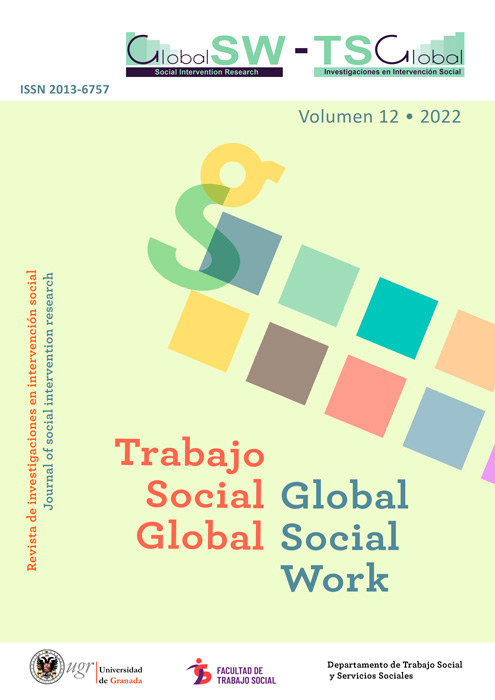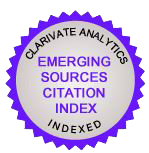New perspectives in Social Health Work’s goals in Primary Health Care
DOI:
https://doi.org/10.30827/tsg-gsw.v12.24403Keywords:
Psychosocial determinants of health; Frequent attenders; Scope of intervention; Overusers.Abstract
The intervention of social work professionals is often limited by restrictive criteria that lead to the exclusion of a segment of the population with psychosocial problems. To situate this specific problem, this article analyses the excessive use of consultations in primary health care. The results of studies in this area are consistent in linking users who make excessive use of consultations with sociodemographic and socio-family problems, as well as psychological problems, including depression, anxiety and a passive coping style. This study explores the response of health social work in the excessive use of consultation in health primary care. For this, a narrative review of the literature related to frequent attendance or overuse and social work, in primary care, and published between the years 1980 and 2020, is carried out. This review reflects that health social work has had a limited impact about such excessive use. Finally, it is concluded that affective social support offers a broad conceptual framework that integrates the disease, as a reality that appears homogeneous, and the subjective and contextual nature of the symptoms.
Downloads
References
Abreu Velázquez, M. C., y Mahtani Chugan, V. (2018). Las funciones de los trabajadores sociales sanitarios en atención primaria de salud: evolución, redefinición y desafíos del rol profesional. Cuadernos de Trabajo Social, 31, 355-368. https://doi.org/10.5209/CUTS.54560
Aragonés, E., Labad, A., Piñol, J. L., Lucena, C., y Alonso, Y. (2005). Somatized depression in primary care attenders. Journal of Psychosomatic Research, 58, 145-151. https://doi.org/10.1016/j.jpsychores.2004.07.010
Ashcroft, R. van Katwyk, T., y Hogarth, K. (2017). An examination of the holism paradigm: a view of social work, Social Work in Public Health, 32, 461-474. https://doi.org/10.1080/19371918.2017.1360818
Barría Muñoz, J. (2021). En defensa del Trabajo Social Clínico. El giro pragmático y la contribución de la terapia familiar sistémica en la práctica con personas y familias. Itinerarios de Trabajo Social, 1, 79-86. https://doi.org/10.1344/itsv0i1.32041
Bellón, J. A., Delgado, A., Luna, J. D., y Lardelli, P. (1999). Psychosocial and health belief variables associated with frequent attendance in primary care. Psychological Medicine, 29, 1347-1357. https://doi.org/10.1017/s0033291799008995
Bellón, J. A., Delgado, A., Luna, J. D., y Lardelli, P. (2007). Patient psychosocial factors and primary care consultation: a cohort study. Family Practice, 24, 562-569. https://doi.org/10.1093/fampra/cmm059
Brownlee, S., Chalkidou, K., Doust, J., Elshaug, A. G., Glasziou, P., Heath, I.,... y Korenstein, D. (2017). Evidence for overuse of medical services around the world. Lancet, 8, 156-168. https://doi.org/10.1016/S0140-6736(16)32585-5
Calvo-Rojas, V. (2016). Hiperfrecuentadores versus normofrecuentadores en atención primaria de salud: factores sociales asociados, estilos de personalidad y psicopatología [tesis doctoral]. Barcelona: Universitat Autònoma de Barcelona. Disponible en: https://bit.ly/36dTM9x
Calvo-Rojas, V., Rodríguez Molinet, J., Pomares Costa, A. M., Gil Rovira, M., Ramell, A. M., Sentís Antolín L.,… y Pedroche Prades, E. (2011). Factores sociales asociados a la hiperfrecuentación en Centros de Atención Primaria de Salud: un estudio desde el Trabajo Social Sanitario. Trabajo Social Global-Global Social Work, 2, 116-142. https://doi.org/10.30827/tsg-gsw.v2i3.922
Cohen, S. (2004). Social Relationships and Health. American Psychologist. https://doi.org/10.1037/0003-066X.59.8.676
Dowrick, C. F., Bellón, J. A., y Gómez, M. J. (2000). GP frequent attendance in Liverpool and Granada: the impact of depressive symptoms. British Journal of General Practice, 50, 361-365.
Díaz, R. (2013). Las necesidades sociales y la hiperfrecuentación de las consultas médicas de atención primaria de salud: el caso de Línea de la Concepción. Trabajo Social y Salud, 76, 101-110
Fuertes, M. C., Carracedo, E., Lorda, A., Arillo, A., Gómez, A. R., y Martínez, M. J. (2017). Intervención con pacientes hiperfrecuentadores persistentes en atención primaria. Medicina General y de Familia, 6, 15-22.
Hauswaldt, J., Himmel, W., y Hummers-Pradier, E. (2013). The inter-contact interval: a new measure to define frequent attenders in primary care. BMC Family Practice, 14, 162-169. https://doi.org/10.1186/1471-2296-14-162
Hodgson, P., Smith, P., Brown, T., y Dowrick, C. (2005). Stories from frequent attenders: a qualitative study in primary care. Annals of Internal Medicine, 3, 318-323. https://doi.org/10.1370/afm.311
Luciano, J. V., y Serrano, A. (2008). Los hiperfrecuentadores en atención primaria: perfil sociodemográfico, características clínicas y propuesta de una nueva definición. Atención Primaria, 40, 631-632. https://doi.org/ 10.1016/S0212-6567(08)75697-X
Malterud, K., Guassora, A. D., Reventlow, S., y Jutel, A. (2017). Embracing uncertainty to advance diagnosis in general practice. British Journal of General Practice, 67, 244-245. https://doi.org/10.3399/bjgp17X690941
Martin, C. M. (2007). Chronic disease and illness care: adding principles of family medicine to address ongoing health system redesign. Canadian Family Physician, 53, 2086-2091.
Matalon, A., Nahmani, T., Rabin, S., Maoz, B., y Hart J. (2002). A short-term intervention in a multidisciplinary referral clinic for primary care frequent attenders: description of the model, patient characteristics and their use of medical resources. Family Practice, 19, 251-256. https://doi.org/10.1093/fampra/19.3.251
Matalon, A., Yaphe, J., Nahmani, T., Portuguez-Chitrit, N., y Maoz B. (2009). The effect of a multi-disciplinary integrative intervention on health status and general health perception in primary care frequent attenders. Families, Systems and Health, 27, 77-84. https://doi.org/10.1037/a0014769
McGregor, J., Mercer, S. W., y Harris, F. M. (2018). Health benefits of primary care social work for adults with complex health and social needs: a systematic review. Health and Social Care in the Community, 26, 1-13. https://doi.org/10.1111/hsc.12337
Menéndez Granados, N., Vaquero Abellán, M., Toledano Estepa, M., Pérez Díaz, M. M., y Redondo Pedraza, R. (2019). Estudio de la hiperfrecuentación en un distrito de atención primaria. Gaceta Sanitaria, 33, 38–44. https://doi.org/10.1016/j.gaceta.2017.07.011
Miranda-Ruche, X., Pirla-Santamaría, A., y Julià-Traveria, R. (2020). La cronicidad en el marco de los servicios sociales: aportaciones para su discusión. Trabajo Social Global-Global Social Work, 10, 94-115. https://doi.org/10.30827/tsg-gsw.v10i18.11331
Morales-Botero, J. J., Montoya-Sierra, S., y Gómez-Arias, R. D. (2021). Condiciones asociadas a la hiperfrecuentación según número anual de consultas en una institución de salud de primer nivel de atención en Medellín, Colombia, 2018. Revista Gerencia y Políticas de Salud, 20. https://doi.org/10.11144/Javeriana.rgps20.cahn
Nettleton, S. (2006). 'I just want permission to be ill': towards a sociology of medically unexplained symptoms. Social Science and Medicine, 62, 1167-1178. https://doi.org/10.1016/j.socscimed.2005.07.030
Opdal, P. Ø., Meland, E., y Hjörleifsson, S. (2019). Dilemmas of medical overuse in general practice – A focus group study. Scandinavian Journal of Primary Health Care, 37, 135-140. https://doi.org/10.1080/02813432.2019.1569370
Parejo Maestre, N., Lendínez-de la Cruz, J. M., Bermúdez-Torres, F. M., González-Contero, L., y Gutiérrez-Espinosa, M. P. (2016). Prevalencia y factores asociados a la hiperfrecuentación en la consulta de medicina de familia. Semergen, 42, 216–224. https://doi.org/10.1016/j.semerg.2015.05.011
Palacios-Gálvez, M. S., Morales-Marente, E., Iáñez-Domínguez, A., y Luque-Ribelles, V. (2021). Impacto de los grupos socioeducativos de atención primaria en la salud mental de las mujeres. Gaceta Sanitaria, 35, 345–351. https://doi.org/10.1016/j.gaceta.2020.02.005
Pymont C., y Butterworth, P. (2015). Longitudinal cohort study describing persistent frequent attenders in Australian primary healthcare. British Medical Journal Open, 5, e008975. https://doi.org/10. 1136/bmjopen-2015-008975
Reho, T. T. M., Atkins, S. A., Talola, N., Viljamaa, M., Sumanen, M. P. T., y Uitti, J. (2019). Frequent attenders in occupational health primary care: a cross-sectional study. Scandinavian Journal of Public Health, 47, 28-36. https://doi.org/10.1177/1403494818777436
Rizzo, V., y Rowe, J. (2006). Studies of the cost-effectiveness of social work services in aging: a review of the literature. Research on Social Work Practice, 16, 67-73. https://doi.org/10.1177/1049731505276080
Rizzo, V., y Rowe, J. (2016). Cost-effectiveness of social work services in aging: an updated systematic review. Research on Social Work Practice, 1, 1-15. https://doi.org/10.1177/1049731514563578
Rodriguez-Lopez, M., Arrivillaga, M., Holguín, J., León, H., Ávila, A., y Hernández, C. (2016). Perfil del paciente hiperfrecuentador y su asociación con el trastorno ansioso depresivo en servicios de atención primaria de Cali, Colombia. Revista Peruana de Medicina Experimental y Salud Publica, 33, 478-88. https://doi.org/10.17843/rpmesp.2016.333.2335
Rodríguez Otero, L. M., y García Álvarez, M. P. (2019). Salud y trabajo social: un análisis desde las perspectivas de la formación y la investigación. Cuadernos de Trabajo Social, 32, 123-139. https://doi.org/10.5209/CUTS.57884
Rojas, P. (2015). Variations of the social: some reflections on public health, social research and the health-society relation. Saúde e Sociedade, 24, 124-140. https://doi.org/10.1590/s0104-12902015s01011
Saini, V, Brownlee, S., Elshaug, A. G., Glasziou, P., Heath, I. (2017). Addressing overuse and underuse around the world. Lancet, 390, 105-107. https://doi.org/10.1016/S0140-6736(16)32573-9
Savageau, J. A., McLoughlin, M., Ursan, A., Bai, Y., Collins, M., y Cashman, S.M. (2006). Characteristics of frequent attenders at a community health center. Journal of the American Board of Family Medicine, 19, 265-275.
Sheehan, B., Bass, C., Briggs, R., y Jacoby, R. (2003). Somatization among older primary care attenders. Psychological Medicine 33, 867-877. https://doi.org/10.1017/s003329170300789x
Shukla, D. M., Faber, E. B., y Sick, B. (2020). Defining and characterizing frequent attenders: systematic literature review and recommendations. Journal of Patient-Centered Research and Reviews, 7, 255-264. https://doi.org/10.17294/2330-0698.1747
Smits, F. T., Wittkampf, K. A., Schene, A. H., Bindels, P. J., y van Weert, H. C. (2008). Interventions on frequent attenders in primary care. a systematic literature review. Scandinavian Journal of Primary Health Care, 26, 111-116. https://doi.org/10.1080/02813430802112997
Smits, F. T., Brouwer, H. J., Zwinderman, A. H., van den Akker, M., van Steenkiste, B., Mohrs, J.,.. y Ter Riet G. (2013). Predictability of persistent frequent attendance in primary care: a temporal and geographical validation study. PLoS ONE, 8, e73125. https://doi.org/10.1371/journal.pone.0073125
Smits, F. T., Brouwer, H. J., Zwinderman, A. H., Mohrs, J., Schene, A. H., van Weert, H. C., y ter Riet, G. (2014). Why do they keep coming back? Psychosocial etiology of persistence of frequent attendance in primary care: a prospective cohort study. Journal of Psychosomatic Research, 77, 492-503. https://doi.org/10.1016/j.jpsychores.2014.08.003
Smits, F. T., Brouwer, H. J., Schene, A. H., van Weert, H.C., y ter Riet, G. (2016). Is frequent attendance of longer duration related to less transient episodes of care? A retrospective analysis of transient and chronic episodes of care. BMJ Open; 6:e012563. https://doi.org/10.1136/bmjopen-2016-012563
Steketee, G., Ross, A. M., y Wachman, M. K. (2017). Health outcomes and costs of social work services: a systematic review. American Journal of Public Health, 107, 256-266. https://doi.org/10.2105/AJPH.2017.304004
Thoits, P.A. (1982). Conceptual, methodological and theoretical problems in studying social support as a buffer against life stress. Journal of Health and Social Behavior, 2, 145-159. https://doi.org/10.2307/2136511
Vázquez Aguado, O. (1998). Pensar la epistemología del trabajo social. Alternativas. Cuadernos de Trabajo Social, 6, 269-286. https://doi.org/10.14198/ALTERN1998.6.13
Vedsted, P., y Christensen, M. B. (2005). Frequent attenders in general practice care: A literature review with special reference to methodological considerations. Public Health, 119, 118-137. https://doi.org/10.1016/j.puhe.2004.03.007
Velasco, S., Ruiz, M. T., Álvarez-Dardet C. (2006). Modelos de atención a los síntomas somáticos sin causa orgánica De los trastornos fisiopatológicos al malestar de las mujeres. Revista Española de Salud Pública, 80, 317-333
Velasco, S., López, B., Tourné, M., Calderó, M. A., Barceló, I., y Luna, C. (2007). Evaluación de una intervención biopsicosocial para el malestar de las mujeres en atención primaria. Feminismo/s, 10, 111-131
Wiklund-Gustin, L. (2013). Struggling on my own: a cognitive perspective on frequent attenders conception of life and their interaction with the healthcare system. Psychiatry Journal, e 580175. https://doi.org/10.1155/2013/580175
Downloads
Published
How to Cite
Issue
Section
License
Authors publishing in this journal agree to the following terms:
- Authors retain their copyright. They guarantee to this journal the right to a first publication of the work submitted to initiate the editorial process.
- Authors know that their work is published under a Creative Commons License which allows others to share it, with a recognition of the work's authorship and its initial publication in this journal.
- Authors share with Global Social Work explotation rights of the work that has been published in this journal, authorizing the execution of a free reproduction, distribution and public communication. Authors know that their work will be stored on servers and reproduced in digital format for inclusion in institutional repositories and databases that will facilitates free access to the full text of the work.
- Authors may distribute the version of the work published in this journal (for example, to an institutional repository or publish it in a book), with the explicit acknowledgment of its initial publication in this journal.
Copyright on the texts published in Trabajo Social Global -Global Social Work, as well as editorial policy of the journal refering to self-file and deposit in institutional or thematic repositories, are identified in the database





















